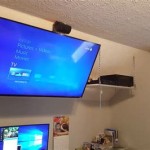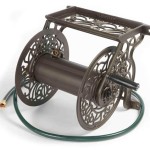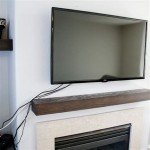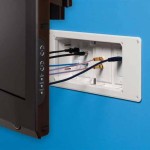Wall Mounted Smart Home Hub: Centralized Control and Enhanced Aesthetics
The modern smart home landscape is characterized by a plethora of devices, each designed to automate and enhance various aspects of daily life. From smart lighting and thermostats to security systems and entertainment centers, the interconnectedness of these devices promises unprecedented convenience and control. However, managing a diverse ecosystem of smart devices can quickly become cumbersome, often requiring users to juggle multiple apps and interfaces. This is where the wall-mounted smart home hub emerges as a compelling solution, offering centralized control and a streamlined user experience while seamlessly integrating into the home's aesthetic.
A wall-mounted smart home hub is a dedicated device, typically featuring a touchscreen interface, designed to manage and control all compatible smart devices within a home network. Unlike mobile apps or voice assistants, which often act as secondary control points, the wall-mounted hub serves as a primary and persistent interface. Its strategic placement on a wall provides readily accessible control for all household members and guests, eliminating the need to search for smartphones or rely on voice commands in every situation. Furthermore, the wall-mounted design adds a touch of sophistication and permanence to the smart home setup, transforming a collection of disparate devices into a unified and elegant system.
Several factors contribute to the growing popularity and relevance of wall-mounted smart home hubs. The increasing complexity of smart home ecosystems necessitates a centralized control point that simplifies device management. The desire for a more intuitive and accessible interface, particularly for those less familiar with smartphone apps or voice assistants, drives the demand for wall-mounted solutions. Moreover, the aesthetic appeal of a dedicated, wall-mounted device that complements the home's décor is a significant consideration for many homeowners.
Simplified Device Management and Interoperability
One of the primary benefits of a wall-mounted smart home hub is its ability to simplify the management of various smart devices. These hubs typically support multiple communication protocols, such as Wi-Fi, Zigbee, Z-Wave, and Bluetooth, enabling them to connect and control a wide range of devices from different manufacturers. This interoperability is crucial, as it allows homeowners to choose the best devices for their needs, regardless of brand, and integrate them seamlessly into a unified smart home system. The hub acts as a translator, bridging the communication gap between devices that might otherwise be incompatible.
The centralized interface of the hub allows users to view the status of all connected devices, control individual devices, and create custom scenes or routines. For example, a user could create a "Good Morning" scene that automatically turns on the lights, adjusts the thermostat, and starts playing music. These scenes can be triggered manually or scheduled to run automatically at specific times. Centralized control eliminates the need to navigate through multiple apps or remember complex voice commands, streamlining the entire smart home experience.
Furthermore, wall-mounted hubs often provide advanced features such as energy monitoring, security alerts, and remote access. Energy monitoring allows users to track their energy consumption and identify opportunities to save money. Security alerts can notify users of potential security breaches, such as open doors or windows. Remote access enables users to control their smart home devices from anywhere in the world, providing added security and convenience. These features are often integrated into a user-friendly dashboard, making it easy for users to manage their smart home and stay informed about its status.
The ability to group devices and control them collectively is another significant advantage. Instead of individually adjusting each light, users can control all the lights in a room or the entire house with a single tap. This is particularly useful for managing large smart home installations or for creating specific moods or ambiances. The wall-mounted hub also provides a clear visual representation of the smart home ecosystem, making it easier to understand the relationships between devices and how they work together.
Enhanced Accessibility and User Experience
Wall-mounted smart home hubs are designed to be easily accessible and intuitive to use, regardless of the user's technical expertise. The large touchscreen interface provides a clear and visual representation of the smart home ecosystem, making it easy to navigate and control devices. The placement of the hub on a wall ensures that it is always within reach and readily available, eliminating the need to search for smartphones or other control devices.
The user interface is typically designed to be simple and intuitive, with clear icons and labels. This makes it easy for all household members, including children and the elderly, to use the hub effectively. The ability to customize the interface and create personalized dashboards further enhances the user experience, allowing users to prioritize the devices and features that are most important to them. Some hubs also offer voice control integration, allowing users to control devices using voice commands in addition to the touchscreen interface.
Furthermore, wall-mounted hubs can be configured to provide specific information and alerts, such as weather forecasts, calendar appointments, and news headlines. This turns the hub into a central information center for the home, providing valuable information at a glance. The ability to customize these alerts and notifications ensures that users are only receiving the information that is most relevant to them.
The physical presence of the hub on the wall also serves as a constant reminder of the smart home's capabilities, encouraging users to explore and utilize its features. Unlike smartphone apps, which can be easily forgotten or buried among other applications, the wall-mounted hub is always visible and accessible. This can lead to increased adoption and utilization of smart home features, maximizing the value of the investment.
Aesthetic Integration and Customization
Beyond functionality, wall-mounted smart home hubs are designed to integrate seamlessly into the home's décor. These devices are typically available in a variety of styles and finishes, allowing homeowners to choose a model that complements their existing aesthetic. The sleek and modern design of many hubs can add a touch of sophistication to any room, transforming a simple control device into a decorative element.
The ability to customize the display and interface further enhances the aesthetic integration. Users can choose from a variety of themes and color schemes to match their personal preferences. Some hubs also allow users to upload custom backgrounds and images, creating a truly personalized look. The ability to adjust the brightness and contrast of the display ensures that the hub blends seamlessly into any lighting conditions.
The discreet and minimalist design of many wall-mounted hubs helps to minimize their visual impact on the room. These devices are often designed to be flush with the wall, creating a clean and seamless appearance. The absence of visible wires and cables further contributes to the clean aesthetic. In some cases, the hub can be integrated into existing smart home panels or recessed into the wall, creating an even more seamless and integrated look.
The strategic placement of the hub on the wall can also enhance its aesthetic appeal. By placing the hub in a central location, such as the entryway or living room, it can become a focal point in the room. The hub can also be used to display artwork, photos, or other visual content, turning it into a digital picture frame when not in use. This versatility makes the wall-mounted hub a valuable addition to any smart home, combining functionality and aesthetics in a single device.
Ultimately, the wall-mounted smart home hub represents a significant advancement in the evolution of smart home technology. Its centralized control, enhanced accessibility, and aesthetic integration offer a compelling alternative to traditional control methods, streamlining the smart home experience and enhancing the overall quality of life. As smart home technology continues to evolve, the wall-mounted hub is poised to play an increasingly important role in shaping the future of the connected home.

S Echo Hub Is A Wall Mountable Home Control Panel Techhive

S 180 Echo Hub Is A Wall Mounted Home Control Panel Techcrunch

This Guy Put A Google Nest Hub Max In His Wall

Apple S Wall Mounted Hub Tipped For Early 2025 Channelnews

White Google Nest Home Hub 1st 2nd Gen Wall Mount S Speaker Holder Bracket

Apple Could Debut A New Wall Mounted Home Hub As Soon Early Next Year Mactrast

Ipad Wall Mount Elago Home Hub Black Australia

Stylish Wall Mounting Kit For Google Nest Hub 2nd Gen In Your Color Design Version 10 Physical Etsy

Making A Dumb Wall Ser S Home Hub Inwall Install

5inch Poe S Home Hub 7 Automation Panel Zigbee Knx Rs485 Control Wall Mount Tablet And








